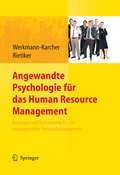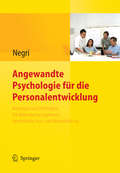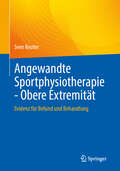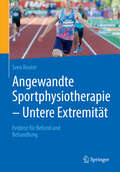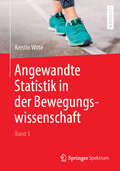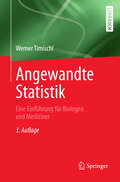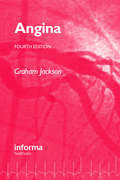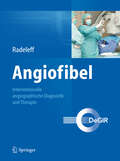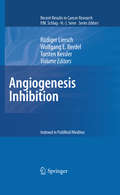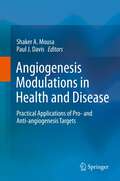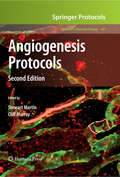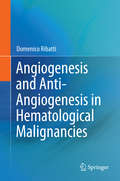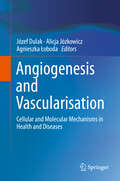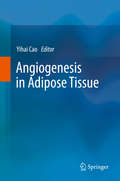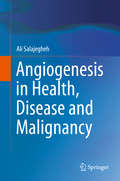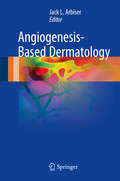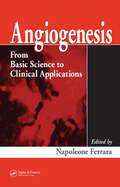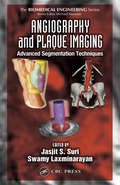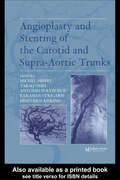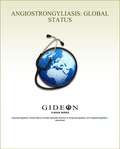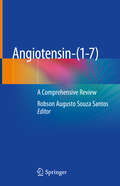- Table View
- List View
Angewandte Lymphologie: Grundlagen - Alltag - Perspektiven
by Erich Brenner Manuel E. Cornely Wolfgang Ch. MarschLymphologische Krankheitsbilder sind häufig, oft bereiten Diagnosestellung und Therapie jedoch Schwierigkeiten. Im klinischen Alltag wurde solchen Erkrankungen zumeist nicht ausreichend Aufmerksamkeit geschenkt, auch weil bislang kurative Behandlungen fehlten. Die Entwicklung neuer diagnostischer und vor allem operativer therapeutischer Verfahren ermöglicht, für einen Teil der Patienten Heilung zu erzielen und ihnen eine jahrzehntelange symptomatische Therapie zu ersparen.Herausgeber, Autoren und die beiden Kommentatoren Peter S. Mortimer und Christian Schuchhardt stellen relevante lymphologische Grundlagen und Krankheitsbilder - auch unter Einschluss eher seltener Erkrankungen - vor. Dieser Wegbegleiter durch den lymphologischen Alltag, ein „Vademecum Lymphologicum", richtet sich gleichermaßen an „Novizen und Adepten“. Er ist auf die praktische Umsetzung von Diagnosefindung sowie Beratung und Betreuung der Patienten fokussiert: Basics der Lymphologie, „Vom Symptom zur Diagnose", umfassende Klinik aus grundlegender und spezieller Sicht, konservative und operative Therapie, Sozialmedizin, Begutachtung sowie Hinweise zu Therapieunterstützung durch Sport und Ernährung für Lymphpatienten werden mit einem Ausblick in die wissenschaftliche Zukunft der Lymphologie abgeschlossen. Jeder Beitrag wird mit einem „Tipp der Editoren" eröffnet und endet mit der Frage „Was ist lymphologisch wichtig zu wissen?“. Das Buch wendet sich an diejenigen ärztlichen und nicht-ärztlichen Berufsgruppen, die Patienten mit lymphologischen Krankheitsbildern sehen und behandeln.
Angewandte Psychologie für das Human Resource Management. Konzepte und Instrumente für ein wirkungsvolles Personalmanagement: Konzepte Und Instrumente Für Ein Wirkungsvolles Personalmanagement
by Birgit Werkmann-Karcher Jack RietikerAuch wenn Personalmanager keine Psychologen sein müssen, was sie tun, ist angewandte Psychologie: u. a. Menschen und ihre Rollen im Unternehmen verstehen und beeinflussen, Wandel in Organisationen gestalten. Dafür kann die Kenntnis psychologischer Instrumente und Theorien sehr hilfreich sein. Dieser Leitfaden basiert auf einer Weiterbildung für Personalmanager am Institut für Angewandte Psychologie (Zürich) und beleuchtet aktuelle Themen wie z. B. Talent-, Performance- und Demografie-Mangement - mit zahlreichen Tipps, Checklisten und Fallbeispielen.
Angewandte Psychologie für die Personalentwicklung. Konzepte und Methoden für Bildungsmanagement, betriebliche Aus- und Weiterbildung: Konzepte Und Methoden Für Bildungsmanagement, Betriebliche Aus- Und Weiterbildung
by Christoph NegriIn Zeiten rasanter Veränderungen in Organisationen und der Wirtschaft insgesamt sind auch Bildungsfachleute und Personalentwickler gefordert, ihre Kernaufgaben neu zu definieren. Dazu bietet die angewandte Psychologie einen Orientierungsrahmen. In dem Band vermitteln Praktiker die psychologischen Grundlagen für eine moderne, nachhaltige betriebliche Bildungsarbeit und Personalentwicklung. Dabei greifen sie auch aktuelle Themen wie E-Learning, erlebnisorientiertes Lernen, Bildungsmarketing, Performance Management oder Corporate Learning auf.
Angewandte Sportphysiotherapie - Obere Extremität: Evidenz für Befund und Behandlung
by Sven ReuterDieses Praxisbuch für Physiotherapeut*innen, Sportwissenschaftler*innen und Sportmediziner*innen ist ein unverzichtbarer Begleiter, um Patient*innen nach Sportverletzungen der oberen Extremität optimal zu befunden und zu behandeln. Bleiben Sie auf dem neuesten Stand der Wissenschaft durch evidenzbasierte Techniken, Assessments und zahlreiche Praxistipps sowie Trainingsbeispiele. Aus dem Inhalt: Klinische Symptome und Diagnostik aller Verletzungen der oberen Extremität, klare Übungsanleitungen und Trainingspläne für alle Rehabilitationsstufen, zielorientiertes Krafttraining, Regenerationsphasen und Funktionsphasen verständlich erklärt, übersichtliche tabellarische Therapieoptionen vereinfachen die Umsetzung.
Angewandte Sportphysiotherapie - Untere Extremität: Evidenz für Befund und Behandlung
by Sven ReuterDieses Praxisbuch liefert Physiotherapeuten, Sportwissenschaftlern und Sportmedizinern einen zuverlässigen Leitfaden für Befund und Behandlung von Verletzungen bei Freizeit- und Profisportlern. Aktuelle Studien und Wirksamkeitsanalysen geben eine konkrete Richtlinie für die Förderung von komplexen Heilungsprozessen, wie z.B. die spezielle Diagnostik des femoroacetabulären Impingements, des patellofemoralen Schmerzsyndroms oder der plantaren Fasziopathie. Die Häufigkeit der wichtigsten Verletzungsmuster ist in übersichtlichen Tabellen zusammengefasst. Aus dem Inhalt: Kriterien für den Übergang in die höhere RehabilitationsstufeLimitationen bei der MobilisationVorgaben zum angepassten KrafttrainingBesonderheiten für neuromuskuläres Training und im Alltag Plus: Tabellen zum Nachbehandlungsschema für jedes Krankheitsbild!
Angewandte Statistik in der Bewegungswissenschaft (Band 3)
by Kerstin WitteDieses Buch soll Studierende als auch Doktoranden motivieren, eigene Studien mit dem richtigen Untersuchungsdesign zu planen und durchzuführen.Für viele bewegungswissenschaftliche Untersuchungen müssen statistische Verfahren angewendet werden. Doch oft fällt es den Studierenden schwer, das jeweils geeignete Verfahren zu finden. Dieser Band soll helfen, insbesondere Studierenden der Sportwissenschaft zu helfen, die statistischen Grundlagen zu verstehen. Dabei unterstützt eine Vielzahl von Übersichten über die Verfahren und Abbildungen ihre Wirkungsweise. Viele sportmotorische Beispiele werden erläutert, um die Anwendbarkeit und den Praxisbezug zu demonstrieren. Zu den vertiefenden Aufgaben gibt es auch einen Abschnitt mit Hinweisen zur Lösung der in Band 2 gestellten empirischen Aufgaben.Auf folgende Themenschwerpunkte wird besonders eingegangen: empirische Forschungsmethoden, deskriptive Statistik, Wahrscheinlichkeitstheorie, Parameterschätzung, Aufstellen und Prüfen von Hypothesen, Verfahren zum Testen von Unterschieds- und Zusammenhangshypothesen, Varianzanalyse, Faktorenanalyse, Testtheorie und Zeitreihenanalyse.
Angewandte Statistik: Eine Einführung für Biologen und Mediziner
by Werner TimischlDie "Angewandte Statistik" ist ein Lehr- und Übungsbuch für Anwenderinnen und Anwender der Statistik, die ein Verständnis für statistische Methoden und eine Sicherheit in der Anwendung dieser Methoden erwerben wollen. Vorausgesetzt wird nur die Kenntnis der für den Universtäts- oder Fachhochschulzugang erforderlichen Schulmathematik. Das Lehrbuch führt zuerst in die Wahrscheinlichkeitsrechnung ein und stellt grundlegende Wahrscheinlichkeitsverteilungen vor. Ausführlich werden die Parameterschätzung und das Testen von Hypothesen behandelt. Mit den gängigen Korrelationsmaßen und ausgewählten Regressionsmodellen wird die statistische Grundbildung abgerundet. Die Kapitel über varianzanalytische Modelle und multivariate Verfahren geben einen Einblick in zwei weitere, für die statistische Praxis relevante Gebiete. Darüber hinaus werden Vertiefungen und spezielle Anwendungen in ergänzenden Abschnitten bereitgestellt. Zahlreiche, vollständig durchgerechnete Beispiele und Übungsaufgaben mit einem ausführlichen Lösungsteil machen die "Angewandte Statistik" zu einem Arbeitsbuch, das sich auch zum Selbststudium eignet. Die Ausrichtung auf die Statistik-Software R (durch Verweise auf die entsprechenden R-Funktionen und die Angabe des R-Codes bei den Lösungen der Aufgaben) trägt der Bedeutung computerunterstützter Problemlösungen in der statistischen Praxis Rechnung.
Angina
by Graham JacksonThis fourth edition of Angina has been extensively revised and expanded with regard to the increasing importance of managing hyperlipidemia, diagnosing and treating coronary artery disease in women and the elderly, and managing chest pain in the presence of normal coronary arteries. Additionally, the roles of medicine, percutaneous coronary interve
Angiofibel: Interventionelle angiographische Diagnostik und Therapie
by Boris A. RadeleffInterventionelle Radiologie Schritt für Schritt Jede Intervention stellt den behandelnden Arzt vor wichtige Fragen: Was ist bei der Patientenaufklärung zu beachten?Welche Materialien sind für diesen speziellen Fall am besten geeignet?Welches ist das optimale Vorgehen?Welche Fallstricke gibt es?Die passenden Antworten gibt das vorliegende Buch. Der Leser erfährt alles Wichtige für seine tägliche Arbeit in der Interventionellen Radiologie (vaskuläre und nicht-vaskuläre, onkologische und Notfalleingriffe). Praktische Handlungsanweisungen und Hinweise zur Vermeidung von Komplikationen runden das als Werkzeug in der täglichen Routine gedachte Werk ab. Viele praktische Tipps erleichtern den Klinikalltag Detaillierte Informationen zu Indikationsstellung und KontraindikationenPatientenvorbereitungAuswahl der erforderlichen MaterialienMethodik des EingriffesMedikamentöse peri- und postinterventionelle TherapieKlinische ErgebnisseKomplikationenAuch der fortgeschrittene Interventionalist findet in diesem Buch viel Neues zur Verfeinerung der Techniken.
Angiofibel: Interventionelle angiographische Diagnostik und Therapie
by Boris RadeleffAngiofibel 2.0 - mit Online-CasesEin detailliertes, vollständig überarbeitetes und erweitertes Arbeitsbuch: unverzichtbar für alle angiographischen Eingriffe, nicht nur für Interventionelle Radiologen, sondern auch fachübergreifend für Gefäßchirurgen, sowie Gastroenterologen.Neue Online-Features in der 2. Auflage:eBook Inside: Downloadcode im Innenteil des Buches für das eBook auf www.springer.com enthalten (kostenlose Registrierung erforderlich)Videos per App: Laden Sie die SpringerNature MoreMedia herunter - Abbildungen im Buch per App mit Handy oder Tablet scannen, um Videos zu streamenPraktische Handlungsanweisungen und Bildbeispiele sowie Hinweise zur Vermeidung und Management von Komplikationen runden das als Arbeitswerkzeug in der täglichen Routine gedachte Werk ab. Neue und erweiterte Kapitel:Notfall Gefäßembolisation: Interkostal-, Lumbalarterie und A. epigastrica inf.Embolisation gynäkologischer Tumor-BlutungenEmbolisation von pulmonalen AV-Fisteln (PAVM)Onkologische EmbolisationTransvaskuläre Therapie der LebermetastasencTACE bei CRM-MetsDEB-TACE bei CRM-MetsIsolierte Chemosaturation (Delcath)Transarterielle Therapie bei CCCTransarterielle Therapie bei neuroendokrinen Karzinommetastasen (MNET)Diagnostik, Klassifikation und Therapie von GefäßanomalienEmbolisation benigner Lebertumore (z.B. FNH)MilzembolisationProstataembolisation
Angiogenesis Inhibition (Recent Results in Cancer Research #180)
by Torsten Kessler Wolfgang E. Berdel Rüdiger LierschAngiogenesis is attracting increased scientific and clinical interest. The identification of novel mediators and targeting molecules has led to significant progress in our understanding of tumor angiogenesis and tumor vessel targeting. Important advances in cancer treatment have already emerged, and in the future, blood vessel targeting will play a significant role within individualized therapeutic strategies. This volume provides a general overview of the latest developments in angiogenesis inhibition in cancer. All aspects from the bench to the bedside are considered, with detailed attention both to basic research and to its translation into clinical practice. Individual chapters are devoted to the roles of angiopoietins, HIF-1a, chemokines, PDGF and VEGF, and vascular integrins. The latest results of clinical trials are presented, and various advanced targeting strategies are discussed. This book will be invaluable to all who wish to learn of the most recent advances in this exciting field.
Angiogenesis Modulations in Health and Disease: Practical Applications of Pro- and Anti-angiogenesis Targets
by Shaker A. Mousa Paul J. DavisThis book is a major update of novel targets in angiogenesis modulation, including pro- and anti-angiogenesis. There is in-depth coverage of preclinical and clinical methods and models, investigational status, and clinical applications. The impact of nanotechnology in advancing the applications of pro-and anti-angiogenesis strategies is also highlighted, along with stem cell and biotechnologies in research and development of angiogenesis modulating targets.
Angiogenesis Protocols (Methods in Molecular Biology #467)
by Cliff Murray Stewart MartinAs experimentation and clinical trials with first generation anti-angiogenic agents have yielded results and our understanding of the biology and physiology of blood and lymphatic vessels has increased, a new angiogenesis volume swiftly became a necessity. Angiogenesis Protocols, Second Edition remains true to its original vision of providing a single source for angiogenesis researchers, irrespective of levels of resource and expertise, by collecting a range of methods for cell isolation and assessing angiogenesis in vivo or in vitro. This information, however, is expanded to include chapters on circulating endothelial progenitor cells, angiogenic signalling pathways, imaging of angiogenesis, and measurement of tissue blood flow. Written in the Methods in Molecular BiologyTM series format, the chapters provide step-by-step laboratory protocols, lists of necessary materials and reagents, and a Notes section, which details tips on troubleshooting and avoiding known pitfalls. Extensive and cutting-edge, Angiogenesis Protocols, Second Edition is not only a practical handbook for key techniques, but also an informative and enjoyable read for all those interested, no matter how directly, in angiogenesis.
Angiogenesis and Anti-Angiogenesis in Hematological Malignancies
by Domenico RibattiIt has been generally accepted that angiogenesis is involved in the pathogenesis of hematological malignancies, like acute and chronic leukemia, lymphoma, myelodysplastic syndromes, myeloproliferative neoplasms and multiple myeloma. The extent of angiogenesis in the bone marrow has been correlated with disease burden, prognosis and treatment outcome. Reciprocal positive and negative interactions between tumor cells and bone marrow stromal cells, namely hematopoietic stem cells, fibroblasts, osteoblasts/osteoclasts, endothelial cells, endothelial progenitor cells, T cells, macrophages and mast cells, mediated by an array of cytokines, receptors and adhesion molecules, modulate the angiogenic response in hematological tumors. More recently, it has been emphasized the pro-angiogenic role of the so called "vascular niche", indicating a site rich in blood vessels where endothelial cells and mural cells such as pericytes and smooth muscle cells create a microenvironment that affects the behavior of several stem and progenitor cells, in hematological malignancies.
Angiogenesis and Vascularisation: Cellular and Molecular Mechanisms in Health and Diseases
by Józef Dulak Alicja Józkowicz Agnieszka ŁobodaThe book presents the overview of the current knowledge in some fields of vascular biology, addressing cellular and molecular aspects of blood-vessel formation and their role in health and disease. The major factors involved in the formation of blood vessels are presented by scientists actively involved in this area of research. Special emphasis is put on the presentation of various molecular mechanisms not addressed in similar works to date. The book is divided into three parts. The first part describes the cells and mediators in angiogenesis. The significance of various populations of potential endothelial progenitors is particularly highlighted. The chapters of the second part focus on molecular mechanisms, with special emphasis on the role of hypoxia, gasotransmitters and reactive oxygen species as well as microRNAs in regulation of angiogenic processes. In the third part, the pathological aspects of disturbed - aggravated or impaired - vascularization are discussed and new modalities for potential therapies are presented. The book is intended for scientists and PhD students in the fields of vascular biology and cancer research. It may be of interest for medical professionals in the fields of cardiovascular disease, diabetes, oncology and rheumatoid arthritis.
Angiogenesis in Adipose Tissue
by Yihai CaoAngiogenesis has recently played a critical role in regulation of adipose tissue expansion and regression. Like most other tissues in the body, adipose expansion and regression is accompanied by alteration of blood vessel density and structures. The vascular alteration plays an active role in regulation of adipose tissue size and functions. Targeting blood vessels in the adipose tissue have demonstrated to be a novel approach for possibly treatment of cancer, obesity and other metabolic diseases. This book provides the most updated information on this type research and discusses future opportunities for therapy..
Angiogenesis in Health, Disease and Malignancy
by Ali SalajeghehThis book is about "Angiogenesis". A process in which new vasculature is formed from pre-existing capillaries. Angiogenesis process is associated with the proliferation and growth of both physiologically normal and neoplastic tissues, through the formation of vascular supply, essential for delivering growth requirements such as oxygen and nutrients. The book describes more than 100 genes and their key regulatory functions in the context of normal healthy condition, disease and malignancy, cancer proliferation and progression. New insights into the role of angiogenesis and the therapeutic inhibition of its regulators are investigated, due to the great potential for exploitation in the development of a novel treatment for cancer. New scientists, junior researchers and biomedical science students will find this book an invaluable introductory reference to their insight about angiogenesis and angiogenic role of more than 100 angiogenes and their role in healthy, disease and malignant conditions.
Angiogenesis-Based Dermatology
by Jack L. ArbiserThis book provides a complete overview of all aspects of angiogenesis in dermatology. This is a guide to the principles of angiogenesis that will allow all involved in dermatology from the medical student and nurse practitioner to the experienced dermatologist to apply these principles for the treatment of patients. <P><P> Angiogenesis is a principle that can be used to guide treatment of diseases of any organ system. Dermatology may be the first specialty to be guided by the principle of angiogenesis because the lesions are visible and response can be easily monitored. Dermatologists already inhibit angiogenesis as part of their treatment of multiple common dermatologic disorders, including acne, warts, and nonmelanoma skin cancer.
Angiogenesis: From Basic Science to Clinical Applications
by Napoleone FerraraWhy a new book on angiogenesis and why now? For the first time concepts proposed over 30 years ago have found clinical validation. In the last two years the first antiangiogenic agents have been approved by the FDA for the treatment of cancer and age-related macular degeneration. Not surprisingly, this clinical success has raised a new set of basic
Angiography and Plaque Imaging: Advanced Segmentation Techniques (Biomedical Engineering Ser.)
by Jasjit S. Suri Swamy LaxminarayanRecent, rapid advances in mathematical engineering and applied mathematics have opened the door to solving complex problems in angiography imaging. For the first time, this book presents the different medical imaging modalities--MR, CT, x-ray, and ultrasound--for performing angiography and its analysis. Pioneers from a variety of relevant disciplin
Angioplasty and Stenting of Carotid and Supra-aortic Trunks
by Michel Henry Dimitrios Kiskinis Takao Ohki Kyriakos Strigaris Antonio Polydorou Chief PatronAlthough carotid endarectomy (CEA) has long been considered the gold standard technique, recent studies report that short- and long-term results with carotid angioplasty and stenting(CAS) are comparable to those with CEA in a significant number of cases. Covering clinical assessment, techniques and devices, medical treatment, and more, Angioplasty
Angiostrongyliasis: Global Status 2010 edition
by Dr Stephen Berger Gideon InformaticsAngiostrongyliasis: Global Status is one in a series of GIDEON ebooks which summarize the status of individual infectious diseases, in every country of the world. Data are based on the GIDEON database (www.gideononline.com) which relies on standard text books, peer-review journals, Health Ministry reports and ProMED, supplemented by an ongoing search of the medical literature. Chapters are arranged alphabetically, by country name. Each section is divided into five subsections. 1. Descriptive epidemiology 2. Summary of clinical features 3. Global status of the disease 4. Status of the disease in a specific country 5. References Angiostrongyliasis: Global Status includes separate sections on Angiostrongyliasis, and Angiostrongyliasis - abdominal.
Angiotensin Protocols (Methods in Molecular Medicine #51)
by Donna H. WangDonna Wang and a panel of hands-on experts describe in step-by-step detail all the major molecular, biochemical, and functional techniques now used in probing the renin-angiotensin system. These range from the use of embryonic gene targeting to create of mutant strains, to the functional investigation of components of the renin-angiotensin system. Comprehensive and highly practical, Angiotensin Protocols translates expert knowledge into readily reproducible methods that enable all biomedical investigators successfully to explore the role of angiotensin in health and disease today.
Angiotensin-(1-7): A Comprehensive Review
by Robson Augusto Souza SantosThis is the first book addressing in full the most important aspects of the angiotensin-(1-7), the key peptide of the protective axis and the main component in the new modulatory concept of the renin-angiotensin system. It features a detailed review of angiotensin-(1-7) and its receptor Mas, comprising the historical background, enzymatic pathways for generation, functions, integrative aspects of its protective profile, and its therapeutic potential. It also encompasses a comprehensive presentation of current knowledge about its widespread biological actions on several tissues, as well as the most recent scientific achievements, emerging from preclinical and clinical trials. Dr. Santos is a renowned researcher on the Renin-Angiontensin system, with remarkable achievements regarding the role of peptides such as alamandine and angiontensin-(1-7). He has also worked on the potential clinical applicability of angiotensin-(1-7)-related drugs for cardiovascular diseases. He has an extensive publication record in the field, including the publication of the book The Protective Arm of the Renin Angiotensin System (Academic Press, 2015).Angiotensin-(1-7) will make a unique contribution to the literature and will be an important resource for biomedical students and researchers, medical practitioners and any other professional interested in this peptide and its role in the renin-angiotensin system.
Angiotensin-converting Enzyme Inhibitors vs. Angiotensin Receptor Blockers: A Critical Analysis of Antihypertensive Strategies: A Machine-Generated Literature Overview
by Mukesh NandaveThis book delves into the various aspects of the renin-angiotensin-aldosterone system (RAAS) and its role in cardiovascular disorders. It explores the use of anti-hypertensive agents, with a focus on (ACE) angiotensin-converting enzyme inhibitors and angiotensin receptor blockers (ARBs). The chapters cover topics such as the preferred use of ACE inhibitors over ARBs in high-risk patients, the impact of these agents on insulin resistance, their role in acute heart failure and peripheral artery disease, and their immunomodulatory activity in hypertensive patients. Additionally, the book examines the role of ACE inhibitors and ARBs in COVID-19 patients and provides insights into recent trends in managing hypertension through RAAS inhibition. It serves as a valuable resource for researchers, clinicians, and healthcare professionals involved in the field of cardiovascular medicine.

